
Rusts are plant diseases caused by pathogenic fungi of the order Pucciniales.

Helicobacter is a genus of Gram-negative bacteria possessing a characteristic helical shape. They were initially considered to be members of the genus Campylobacter, but in 1989, Goodwin et al. published sufficient reasons to justify the new genus name Helicobacter. The genus Helicobacter contains about 35 species.

Viverridae is a family of small to medium-sized mammals, the viverrids, comprising 15 genera, which are subdivided into 38 species. This family was named and first described by John Edward Gray in 1821. Viverrids occur all over Africa, southern Europe, and South and Southeast Asia, across the Wallace Line. Their occurrence in Sulawesi and in some of the adjoining islands shows them to be ancient inhabitants of the Old World tropics.

Berberis, commonly known as barberry, is a large genus of deciduous and evergreen shrubs from 1–5 m (3.3–16.4 ft) tall, found throughout temperate and subtropical regions of the world. Species diversity is greatest in South America and Asia; Europe, Africa and North America have native species as well. The best-known Berberis species is the European barberry, Berberis vulgaris, which is common in Europe, North Africa, the Middle East, and central Asia, and has been widely introduced in North America. Many of the species have spines on the shoots and all along the margins of the leaves.

Joseph Charles Arthur was a pioneer American plant pathologist and mycologist best known for his work with the parasitic rust fungi (Pucciniales). He was a charter member of the Botanical Society of America, the Mycological Society of America, and the American Phytopathological Society. He was a recipient of the first Doctorate in Sciences awarded by Cornell University. The standard author abbreviation Arthur is used to indicate this person as the author when citing a botanical name.
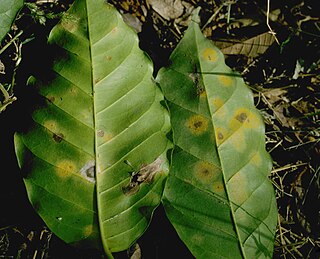
Hemileia vastatrix is a fungus of the order Pucciniales that causes coffee leaf rust, a disease that is devastating to susceptible coffee plantations. Coffee serves as the obligate host of coffee rust, that is, the rust must have access to and come into physical contact with coffee in order to survive. There is no cure at the moment, although farms have managed to reduce their impact by replanting infected farms with hybrids that have a strong genetic resistance to rust.

Neosodon was a genus of sauropod dinosaur from the Late Tithonian-age Upper Jurassic Sables et Gres a Trigonia gibbosa of Départment du Pas-de-Calais, France. It has never been formally given a species name, but is often seen as N. praecursor, which actually comes from a different animal. Often in the past, it had been assigned to the wastebasket taxon Pelorosaurus, but restudy has suggested that it could be related to Turiasaurus, a roughly-contemporaneous giant Spanish sauropod. It is only known from six teeth.
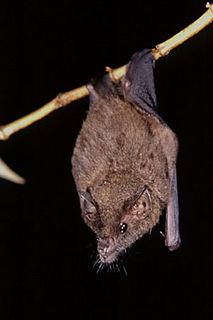
Anoura is a genus of leaf-nosed bats from Central and South America. Anoura members lack or have a short tail, and are nectarivorous bats of small to medium size among the Phyllostomidae.

Amnicolidae is a family of small freshwater snails with a gill and an operculum, aquatic gastropod mollusks in the superfamily Rissooidea.
Paula Claire Rodriguez Rust is an American sociologist who studies sexual orientation, especially bisexuality. Rust is editor of Bisexuality in the United States and author of Bisexuality and the Challenge to Lesbian Politics: Sex, Loyalty, and Revolution.
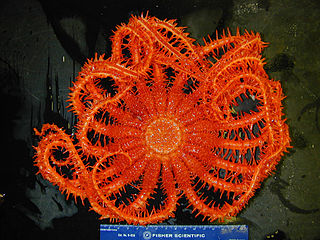
The Brisingids are deep-sea-dwelling starfish in the order Brisingida.
Coralliophila aedonia is a species of sea snail, a marine gastropod mollusk in the family Muricidae, the murex snails or rock snails.
Scyllarus pygmaeus is a species of slipper lobster that lives in shallow water in the Mediterranean Sea and eastern Atlantic Ocean. It grows to a length of 55 mm (2.2 in), which is too small for it to be fished for. The juvenile form was first described in 1885, with the description of the adult following in 1888 as a result of the Challenger expedition.
Dragmacidon lunaecharta, also known as the red ball sponge or red boring sponge, is a species of sea sponge found in the western Atlantic Ocean. It feeds on plankton. These sponges do not attach themselves to rocks or the sea floor but drift in water currents. Its main predators are seaslugs. It has been kept in home aquariums.

Ypresiomyrma is an extinct genus of ants in the subfamily Myrmeciinae that was described in 2006. There are four species described; one species is from the Isle of Fur in Denmark, two are from the McAbee Fossil Beds in British Columbia, Canada, and the fourth from the Bol’shaya Svetlovodnaya fossil site in Russia. The queens of this genus are large, the mandibles are elongated and the eyes are well developed; a stinger is also present. The behaviour of these ants would have been similar to that of extant Myrmeciinae ants, such as solitary foraging for arthropod prey and never leaving pheromone trails. The alates were poor flyers due to their size, and birds and animals most likely preyed on these ants. Ypresiomyrma is not assigned to any tribe, and is instead generally regarded as incertae sedis within Myrmeciinae. However, some authors believe Ypresiomyrma should be assigned as incertae sedis within Formicidae.
Finschia is a genus of three recognised species of large trees, constituting part of the plant family Proteaceae. They grow naturally in New Guinea and its surrounding region, in habitats from luxuriant lowland rainforests to steep highland forests.
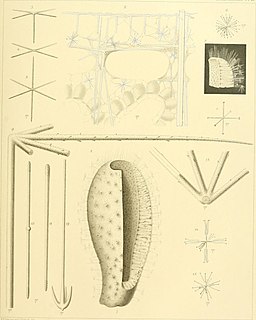
Rossellidae is a family of glass sponges belonging to the order Lyssacinosa.

John Robertson Henderson CIE FRSE FZS FLS was a Scottish zoologist who specialized in the taxonomy of marine crustaceans, particularly the decapods, and worked on specimens collected by the oceanic research vessels Investigator and Challenger. From 1892 until 1911 he was Professor of Zoology at Madras Christian College in India. From 1908 to 1920 he was Superintendent of the Government Museum in Madras. He also took an interest in numismatics and Indian history.
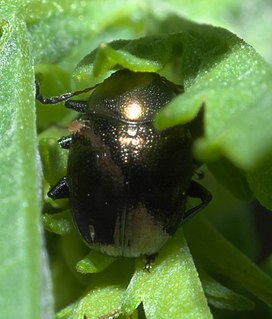
Eumolpini is a tribe of leaf beetles in the subfamily Eumolpinae. It is the largest tribe in the subfamily, with approximately 170 genera found worldwide. Members of the tribe almost always have a longitudinal median groove on the pygidium, which possibly helps to keep the elytra locked at rest. They also generally have a subglabrous body, as well as appendiculate pretarsal claws.
Polyeunoa is a genus of marine annelids in the family Polynoidae. The genus contains two species, one from the Indian Ocean and the other widespread in the south-west Atlantic ocean and the Southern Ocean.














